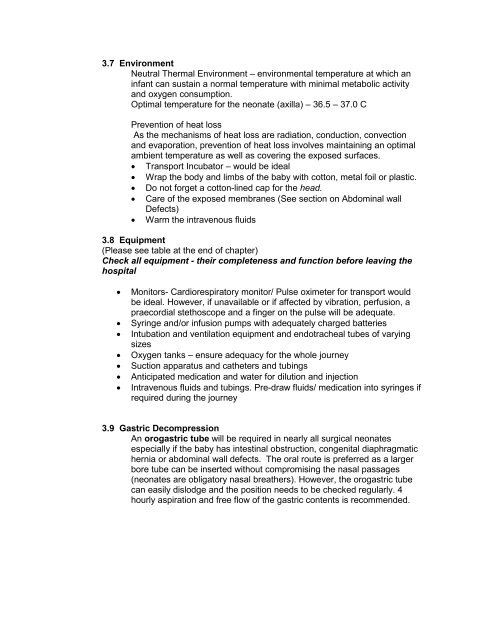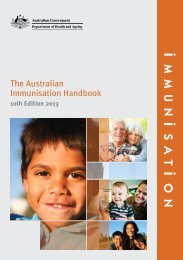Contents Chapter Topic Page Neonatology Respiratory Cardiology
Contents Chapter Topic Page Neonatology Respiratory Cardiology
Contents Chapter Topic Page Neonatology Respiratory Cardiology
You also want an ePaper? Increase the reach of your titles
YUMPU automatically turns print PDFs into web optimized ePapers that Google loves.
3.7 Environment<br />
Neutral Thermal Environment – environmental temperature at which an<br />
infant can sustain a normal temperature with minimal metabolic activity<br />
and oxygen consumption.<br />
Optimal temperature for the neonate (axilla) – 36.5 – 37.0 C<br />
Prevention of heat loss<br />
As the mechanisms of heat loss are radiation, conduction, convection<br />
and evaporation, prevention of heat loss involves maintaining an optimal<br />
ambient temperature as well as covering the exposed surfaces.<br />
• Transport Incubator – would be ideal<br />
• Wrap the body and limbs of the baby with cotton, metal foil or plastic.<br />
• Do not forget a cotton-lined cap for the head.<br />
• Care of the exposed membranes (See section on Abdominal wall<br />
Defects)<br />
• Warm the intravenous fluids<br />
3.8 Equipment<br />
(Please see table at the end of chapter)<br />
Check all equipment - their completeness and function before leaving the<br />
hospital<br />
• Monitors- Cardiorespiratory monitor/ Pulse oximeter for transport would<br />
be ideal. However, if unavailable or if affected by vibration, perfusion, a<br />
praecordial stethoscope and a finger on the pulse will be adequate.<br />
• Syringe and/or infusion pumps with adequately charged batteries<br />
• Intubation and ventilation equipment and endotracheal tubes of varying<br />
sizes<br />
• Oxygen tanks – ensure adequacy for the whole journey<br />
• Suction apparatus and catheters and tubings<br />
• Anticipated medication and water for dilution and injection<br />
• Intravenous fluids and tubings. Pre-draw fluids/ medication into syringes if<br />
required during the journey<br />
3.9 Gastric Decompression<br />
An orogastric tube will be required in nearly all surgical neonates<br />
especially if the baby has intestinal obstruction, congenital diaphragmatic<br />
hernia or abdominal wall defects. The oral route is preferred as a larger<br />
bore tube can be inserted without compromising the nasal passages<br />
(neonates are obligatory nasal breathers). However, the orogastric tube<br />
can easily dislodge and the position needs to be checked regularly. 4<br />
hourly aspiration and free flow of the gastric contents is recommended.
















